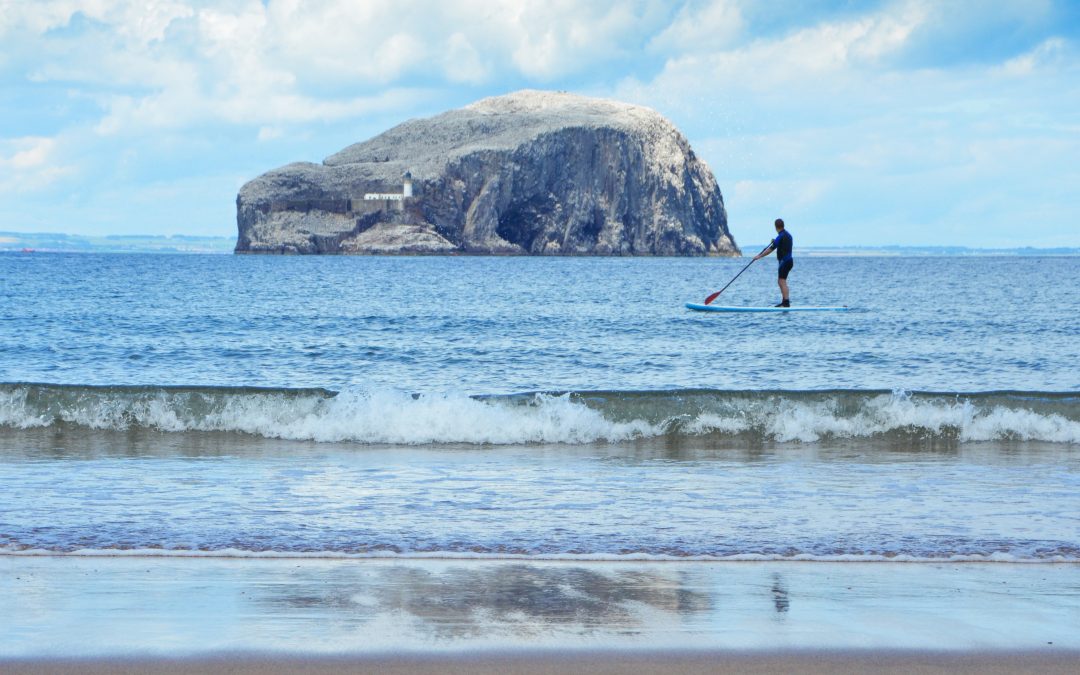The Bass Rock has a rich history that dates back to the 7th century when it was used as a retreat by Saint Baldred. Over the centuries, it has been used for various purposes, including as a fortress, a prison, and a lighthouse. Today, it is a designated nature reserve and is managed by the Scottish Seabird Centre. Visitors can take a boat tour around the rock or even land on it to explore its rugged terrain and observe the birds up close. The Bass Rock is truly a remarkable natural wonder that is not to be missed when visiting East Lothian.
Geographical Overview
Location
The Bass Rock is a small island situated in the Firth of Forth, off the coast of East Lothian in Scotland. It is about 2 km offshore and can be seen from several vantage points on the mainland, including Edinburgh and Berwick Law.
Volcanic Formation
The Bass Rock is one of several volcanic formations in the area, including Berwick Law, which is another volcanic plug located just south of Edinburgh. The rock is also home to a large colony of gannets, which have made the island their home for centuries.
Bass Rock History
Castle
The castle was strategically located and played an important role in the wars between Scotland and England. During the Commonwealth period, the castle was used as a prison for Covenanters, who were Scottish Presbyterians who opposed the rule of the English monarchs.
Prison
The prison on the Bass Rock was notorious for its harsh conditions. The prisoners were kept in cramped and unsanitary conditions, and many died from disease and starvation. The most famous prisoner was John Blackadder, a Presbyterian minister who was imprisoned on the island for his religious beliefs.
During the time of Oliver Cromwell, the castle was used as a garrison and was heavily fortified. The castle was eventually abandoned in the 18th century, and it fell into disrepair.
Relevant Entities:
- Castle
- Prison
- Lauder family
- Commonwealth period
- Cromwell
- Tantallon Castle
Wildlife and Biodiversity
Bird Species
The Bass Rock is home to a diverse range of bird species, making it a popular destination for birdwatchers and nature enthusiasts. The most famous inhabitants of the rock are the Northern Gannets, with over 150,000 birds nesting on the island during the breeding season. The Scottish Seabird Centre offers visitors the chance to observe these magnificent birds up close with their live camera feeds.
Other species of seabirds that can be found on the Bass Rock include Guillemots, Razorbills, Shags, and Kittiwakes. Puffins, with their distinctive colourful beaks, are also present on the island, although in smaller numbers compared to other species.
Marine Life
In addition to its impressive bird population, the Bass Rock is also home to a variety of marine life. The waters around the island are rich in nutrients, making it an ideal habitat for a range of fish and other sea creatures.
Visitors to the Bass Rock may be lucky enough to spot dolphins, porpoises, and seals swimming in the surrounding waters. The island’s location also makes it an important breeding ground for grey seals, with around 2,000 pups born on the island each year.
Sir David Attenborough has described the Bass Rock as one of the “wildlife wonders of the world”, and it’s easy to see why. Whether you’re a birdwatcher, nature lover, or simply looking for a unique and unforgettable experience, the Bass Rock is a must-visit destination.
Bass Rock Lighthouse
The Bass Rock Lighthouse is a prominent feature of the Bass Rock, located in the Firth of Forth, East Lothian. The lighthouse was built in 1902 and stands tall at 20 meters high. It was designed by David Alan Stevenson, a Scottish lighthouse engineer and a member of the famous Stevenson family, which includes the famous author Robert Louis Stevenson.
The lighthouse was built to guide ships safely through the treacherous waters around the Bass Rock. It is equipped with a powerful light that can be seen from up to 26 nautical miles away. The lighthouse also features a foghorn, which is used during times of low visibility to alert ships of the presence of the rock.
The Bass Rock Lighthouse is still in operation today, and it is maintained by the Northern Lighthouse Board. The lighthouse is not open to the public, but visitors can take boat tours around the Bass Rock to see the lighthouse up close.
Tourism and Recreation
The Bass Rock is a popular destination for tourists and nature enthusiasts alike. Visitors can take boat trips from North Berwick to the island, providing stunning views of the rock and its surrounding area. Boat trips are a great way to experience the island and its wildlife up close.
Boat Trips
Boat trips to the Bass Rock are available from North Berwick throughout the year. The trips are operated by various companies, including RIB boat trips and larger vessels. Visitors can choose from a range of options, including guided tours and self-guided trips.
Scottish Seabird Centre
The Scottish Seabird Centre in North Berwick is an excellent resource for visitors interested in learning more about the Bass Rock and its wildlife. The centre provides information on the history and ecology of the island, as well as offering interactive exhibits and live webcams of the seabird colonies.
Visitors can also take boat trips from the centre to the Isle of May, another important seabird colony in the area. The centre is open year-round and is a great place to start your Bass Rock adventure.
Cultural Significance
The Bass Rock is a site of great cultural significance, with a rich history that spans centuries. The rock has been the subject of literary works and has played a role in religious practices.
Literary References
The Bass Rock has been mentioned in several literary works, including the famous play “Macbeth” by William Shakespeare. In Act 1, Scene 3, the character Banquo describes the rock as “the Witches’ Island” and speaks of the “caverns / Where the wild sea-mew / Breeds”. The rock has also been mentioned in the works of Sir Walter Scott and Robert Louis Stevenson.
Religious Significance
The Bass Rock has a long history of religious significance. It is believed that St. Baldred, a Christian hermit, lived on the rock in the 8th century. St. Baldred is said to have established a chapel on the rock and to have performed miracles there. The rock continued to be a site of religious significance in the following centuries, with Christian hermits living on the rock at various times.
Today, the rock is still a site of religious significance, with an annual pilgrimage taking place in honor of St. Baldred. The pilgrimage involves a walk from North Berwick to the rock and a service on the rock itself.
Nearby Islands
The Bass Rock is not the only island worth visiting in the area. There are several other islands nearby that offer unique experiences and stunning views. Here are some of the most notable ones:
Craigleith
Craigleith is a small island located just off the coast of North Berwick. It is home to a large colony of puffins, which can be seen up close during the breeding season. The island is also a popular spot for birdwatching, with a variety of seabirds nesting there. Visitors can take boat tours to the island or view it from the coast.
Lamb
Lamb is a uninhabited island located east of North Berwick. It is a nature reserve and a designated Site of Special Scientific Interest due to its unique geology. The island is home to a variety of seabirds, including puffins, guillemots, and razorbills. Visitors can take boat tours to the island or view it from the coast.
Fidra
Fidra is a small island located just off the coast of North Berwick. It is perhaps best known as the inspiration for Robert Louis Stevenson’s Treasure Island. The island is home to a lighthouse and a large colony of seabirds. Visitors can take boat tours to the island or view it from the coast.
Isle of May
The Isle of May is a larger island located in the Firth of Forth. It is a national nature reserve and a designated Site of Special Scientific Interest. The island is home to a variety of seabirds, including puffins, guillemots, and razorbills, as well as grey seals. Visitors can take boat tours to the island or stay overnight in the bird observatory.

